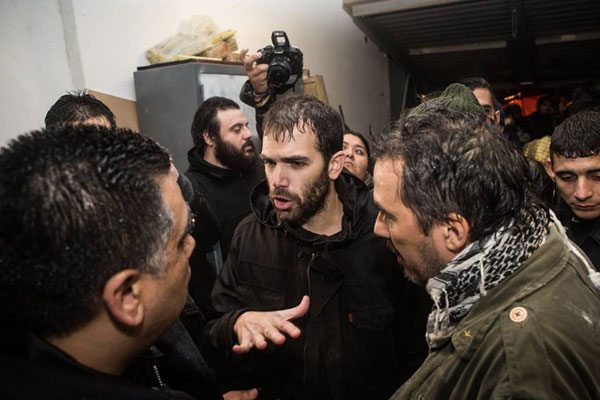
March 21, 2018; Journalism in the Americas
“At the end of 2001, Argentina’s political and economic crisis was the main theme in Latin American news coverage,” notes Carolina de Assis in Journalism in the Americas, a blog maintained by the Knight Center at the University of Texas at Austin. In response to the economic crisis, workers seized control of many abandoned factories. The rise of these “recuperated businesses” (empresas recuperadas), as they came to be called, were profiled in the documentary The Take. And the sector continues to grow; as of 2013, 311 worker-recuperated enterprises employed 13,642 workers, according to a University of Buenos Aires study.
Workers co-ops in Argentina are common in the textile and metalworking sectors, de Assis points out. However, she adds, “in the last two years and for the first time, media outlets were the majority of companies recuperated in Argentina in the period, according to a survey of the Open Faculty Program of the University of Buenos Aires.”
Between 2016 and 2017, at least six media outlets “were recuperated by their workers after they were closed or abandoned by their owners,” de Assis reports. These include “La Nueva Mañana, in Córdoba; El Ciudadano of Rosario; La Portada, of Esquel; and El Correo, of Firmat; plus the newspaper Tiempo Argentino and online news site Infonews, both based in Buenos Aires.” By contrast, between 2010 and 2013, only one media outlet became worker-owned.
According to Natalia Bauni of the Social Observatory on Recuperated and Self-Managed Companies (Osera), also based at the University of Buenos Aires, worker co-ops have offered job protection to “older, salaried workers, who found it practically impossible to insert themselves in the labor market.” Bauni notes that Argentine Bankruptcy Law enables workers to take over bankrupt companies.
Conditions for journalists in Argentina are difficult. As of May 2016, the Argentine journalists’ union said there had been 2,500 layoffs in the sector.
The case of Tiempo is illustrative. The newspaper had relied on government advertisements for income; following a change in party in La Casa Rosada (the president’s residence; literally, the Pink House), the paper lost ad revenue and stopped printing in February 2016.
De Assis explains what came next:
Sign up for our free newsletters
Subscribe to NPQ's newsletters to have our top stories delivered directly to your inbox.
By signing up, you agree to our privacy policy and terms of use, and to receive messages from NPQ and our partners.
After three months of unpaid work and attempts to contact the owner of the newspaper and understand the future of Tiempo Argentino, about 100 journalists decided to organize and occupy the newsroom…. One decision was to produce a special print edition to be sold at the demonstration in Buenos Aires on March 24, the annual date in which Argentina recalls the 30,000 dead and disappeared by the military dictatorship between 1976 and 1983.
The journalists themselves went to the streets of the Argentine capital to sell the special copies and ask the public if there was interest in continuing to support Tiempo if the newspaper were recuperated by its workers. The 30,000 printed copies were sold and the public response was positive. “We decided then to take the money collected and share it among those who had not been paid in three months, and the rest was saved to make the first two editions of a cooperative newspaper,” [now newspaper president Javier] Borelli said. The first edition of Tiempo Argentino as a cooperative-owned newspaper was launched one month later in April 2016.
Converting the business to worker ownership was not without drama, including one night when a “gang of 16 men rushed into the Tiempo Argentino newsroom after midnight” in a failed violent attempt to shut the publication down.
Today, Tiempo employs about 100 people, including journalists, designers, photographers, and newspaper management staff. “In some cases, they only dedicate themselves to functions that have nothing to do with journalism, and in some cases they have a double function. They continue writing for the newspaper, and at the same time they do the commercial relations, organize the work, different administrative tasks,” Borelli says. The newspaper today is “a digital newspaper from Monday to Saturday and a print edition on Sundays,” Borelli explains.
As for its business model, Borelli says that 70 percent of Tiempo’s income is from readers, both buyers and subscribers, as well as supporting members, who contribute 120 pesos a month (about US $6) to the publication. Another 20 percent of revenues are from advertising and 10 percent is event-related, such as journalism workshops. “Today we have almost 2,000 people that are members of the newspaper, additionally we have about 2,500 who are subscribers of the print newspaper,” says Borelli.
Borelli notes that “the cooperatives of journalists dedicated to recuperating media open new paths for professionals and journalism,” de Assis writes. “Somehow, Tiempo managed to prove that it was possible to make a media cooperative sustained by readers,” Borelli adds.
For Borelli, the experience of Tiempo “opens expectations at a time when many jobs are being lost and where information is limited by what the interests of the owners are. As it is a moment of crisis, it can also be a very interesting moment to explore other ways of doing journalism.”—Steve Dubb











